
Like so many people all over the world, I love chocolate. Any chocolate, really, but I'm more of a dark chocolate kind of girl, most of the time. That doesn't mean, however, I don't pay respect to other kinds with lower content of cacao - or none, even. That is white chocolate, and I am quite frankly puzzled by just how many people don't care for it. Their reasoning for such despise may range from 'because it's too sweet' to that common (and factual, technically) claim, namely: 'because it is NOT chocolate'. Yes, I've heard people claiming so a lot of times.
To me, though, it doesn't really matter whether or not white chocolate is chocolate by definition. As much as I simply adore the intensity and richness of bittersweet chocolate, it sometimes just have to be white chocolate - milky, mellow, and sweet - without the bitterness or assertiveness of dark chocolate, but just as satisfying.
And as someone who happens to be as much a sucker for caramel as for chocolate of any shade, I literally gasped at the notion of caramelized white chocolate about a month ago, over at a blog that is almost as addictive as chocolate itself, by pastry chef Monsieur David Lebovitz, who was sharing highlights of his recent experience at a chocolate making program for professionals at Valrhona 's chocolate school here.
Caramelized white chocolate, as it turns out, is basically white chocolate slow-cooked at a low teperature until caramelized - the idea is a bit like cooking condensed milk into dulce de leche. But the idea just never occurred to me, and I was completely blown away just by the idea of caramelizing white chocolate itself, even if I'd always secretly loved those browned bits of white chocolate chunks sticking out of white chocolate chip cookies. I was really intrigued, and I was hardly the only one, obviously; in response to the enthusiastic reactions of lots of readers, David suggested he'd try and come up with the recipe for it, which he did about a week ago.
I'd seen some sneak-peek pictures (like this) in the evening before, and read the post that morning, and I was really excited. Yet I had a work deadline coming up, and had to wait (or more precisely, work) until that evening before I could go out and get some white chocolate (from Valrhona) to finally experience it myself, in my own kitchen. I couldn't wait to taste it.
The wait, however, turned out to be a bit longer than I had expected, for a combination of reasons but mainly due to our tiny, counter-top all-in-one-but-not-doing-any-of-it-right microwave/conventional oven. Okay, and myself, too, for having not been able to tame the box after all these years.
The thing about this oven is, everything takes at least twice as long to cook as it is suggested in a recipe. And that's when you have set the oven temperature considerably higher than specified. On top of that, you almost always need to flip over what you are baking - cakes, cookies, muffins, whatever, to make sure both the top and bottom sides are cooked. I wish I was joking.
The truth is, this is more of a microwave than a 'real' oven, and it only has a round turntable that sits and spins inside at the bottom of the oven - there is no such thing as a top, middle, or bottom rack. Heat circulation is shockingly poor, with virtually no heat applied from below. Now I think of it, it's a bit like a broiler than an oven - with extremely low heat. Well, maybe not.
A very sensible argument that I should simply be buying a real oven aside for now, I ventured to caramelize my white chocolate anyways. Afraid of overcooking the chocolate, I started with 120C (250F) just as specified by the recipe, checking back and give a stir every ten minutes or so. It was around one o'clock in the morning, I guess, and I hoped I'd be done in a few hours. Oh how little did I know.
After eight or ten rounds, or a couple of hours of doing this without any visible change in the appearance or texture of melted chocolate, I decided to up the temperature a bit. I also gave a little longer intervals between the stirs - maybe 20 or even 30 minutes or so, as I realized that every time I open the oven door to stir the chocolate, it'd allow the cooking heat to escape and the inside temperature would drop quite a bit, leaving the chocolate to cook at temperatures lower than it should be.
Another few hours passed without any noticeable change, and I eventually fell asleep for the night (or more like morning, but still). (The oven, by the way, at least does timed cooking, so this was okay.) When I woke up about four or five hours later and looked inside the oven, to my disappointment, the chocolate looked just as pale as it originally had when I had started cooking it. Taking a deep breath, I re-set the oven and resumed cooking, at further bit higher temperature (160C/325F) and little longer intervals (30 minutes).
Now I don't remember what I did for the rest of the day. I guess I worked a bit and did other stuff, checking the chocolate now every 30 minutes or so. I don't remember, either, when the chocolate finally started taking on a brown tinge. I just went on, still making sure the chocolate would not be overcooked. But the truth was, it was way undercooked. Forever.
A few times I thought about quitting. If nothing else, the chocolate was delicious - I knew it because I took a tiny lick of it off the spatula every time I gave it a stir. And yet, it was not caramelized. I was probably too curious, or maybe obsessed, to give up. So I carried on.
When I finally reached the point where I thought I had cooked my chocolate long enough, it was well passed midnight - almost exactly 24 hours after I first popped the sheet into the oven. And what was really ironic is, I ended up overbaking it a bit; I couldn't tell when to stop!
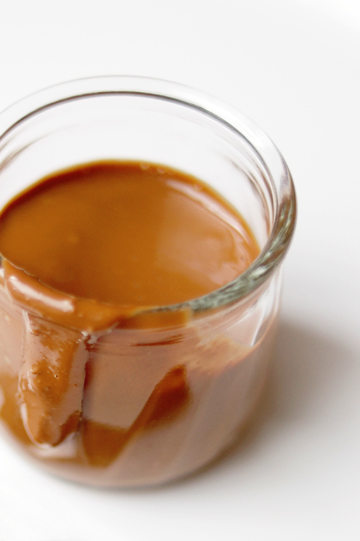
Thus my first ever batch of caramelized white chocolate turned out to be a little grainy like David has warmed it could be if overbaked. I could have strained through a sieve to smooth it out, but it wasn't so as to bother me, and I was alright with it. And boy, I loved it - sweet and milky like regular (good) white chocolate, yet with slight but definite bitterness as a result of caramelization. I was so glad I had't quit.
While I was quite happy with just licking it straight off a small jar, I was also excited to try it out with other things. For now though, I wanted to keep things simple - you can say I was just being lazy, but I mean, when it has taken you give or take 24 hours to make it, the last thing you would want to do is mask the taste of it with something else.
So here are how I made the most of my precious jars of caramelized white chocolate:
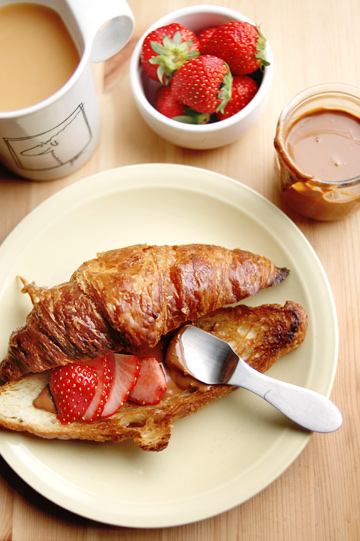
- With a croissant: toasted croissant halves were spread with the caramel and topped with sliced fresh strawberries. This was my take on a pain au chocolat...blanc caramélisé et aux fraises, maybe?? Okay, nobody in/from France would probably accept this to be called a pain au chocolat in any way, but my point is, this quintessential French breakfast pastry would make a perfect vehicle for the sweet caramel. And it certainly did!
I think the additional topping of strawberries dolled things up nicely, but caramelized white chocolate alone could have completed the quick pastry treat, too. I used the berries here only because I had bought them for another use, which was this:
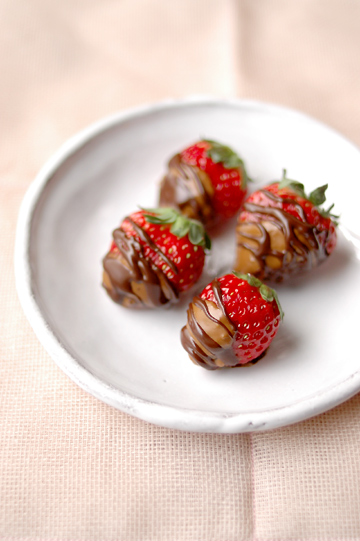
- With strawberries: fresh strawberries are gorgeous dipped in chocolate of any color, so it seemed only natural to try caramelized white chocolate with them, too.
However, Japanese strawberries in general are quite sweet, and I find it a tad bit too much to pair them with the also sweet white chocolate alone. So here I gave them drizzles of melted dark chocolate, too, to give a little bit of kick to the sweet-on-sweet pair. It, of course, went well, but as it turned out, the lightly bitter caramel did the same trick; the berries were delish covered in the caramel, with or without dark chocolate.
After a warm pastry and chilled berries, the caramelized chocolate now found its way over something icy cold...
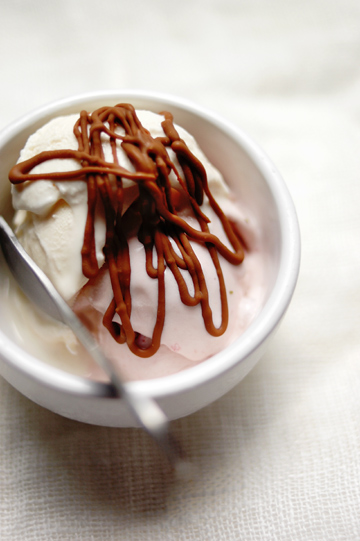
- With ice-cream! Along with the recipe David did suggest that the caramel might be nice swirled into ice-cream. As much as it sounded great, I was (again!) being too lazy to make my own ice-cream, so instead just went for some vanilla and strawberry (again!) Haagen Dazs.
The whole thing tasted nice and sweet, although I would probably have liked my caramel to stay as a 'sauce' rather than harden up straight away upon contact with the cold ice-cream. Next time I would at least add a bit of cream to thin down the caramel, just a bit. Or better yet, maybe make my own batch of ice-cream from scratch.
By now you might probably think that I didn't do too much with the caramelized white chocolate, other than simply spooning it over store-bought this or that. Not that I think there is anything wrong with it, but I didn't mind pushing the envelope a bit further - just a bit, you know.
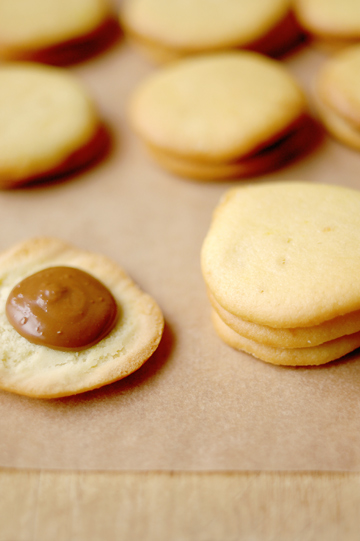
Then I thought about cookies. I could have done something like brownies or layer cakes, I think, but I was feeling like cookies. I was still not totally convinced with baking with the caramelized chocolate (not sure how it'd act when heated), so I decided to fill cookies with the caramel.
First I was going to do my favorite recipe for sandwich cookies, ones that are studded with finely chopped hazelnuts and filled with gooey caramel, which should easily be replaced by carameliezd white chocolate. I also thought about cookies flavored with lemon or orange, as both have a natural affinity with white chocolate and caramel. Then it suddenly occurred to me: alfajores. Filled with dulce de leche, alfafor is a popular cookie in Latin America, and making it with caramelized white chocolate in place of dulce de leche seemed like a great (and safe) bet to me. Yeah, why not?
When I thought about alfajores, the first recipe that came to my mind was the one presented by Matt a couple of years back. They looked simply gorgeous. But I did search for other alfafor recipes, just in case, and eventually went back to Matt's - or more precisely, the version he shared when he appeared on Martha Stewart, which was a slightly different from the one he has on his blog. The MS version uses butter instead of shortening, and some juice of orange along with milk. As I don't stock shortening in my kitchen and the citrus flavor was something I wanted to add to my cookies, I opted for this one - with an addition of grated orange zest and a little higher ratio of orange juice to milk, to boost the orange flavor in the cookies.
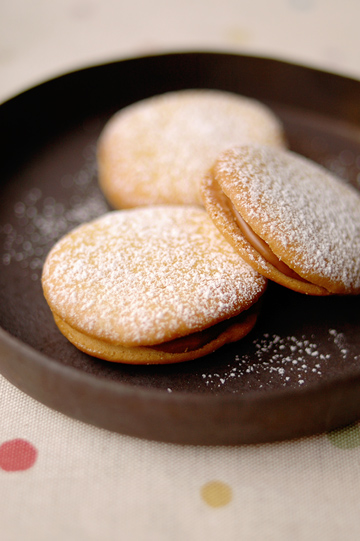
If you excuse me for the somewhat nonuniform shapes, sizes, and thickness of the specimens (I did have to flip them over in the middle of baking, thank you very much), I can assure you that these were one of the best cookies I've had in a long time. Cookies were fantastically soft and light, especially right out of the oven - I thought they weren't going to make it to the sandwiching part! Good thing I managed to save some, though, as the finished sandwiches were true delicacies and oh-so moreish.
Like Matt made a point in his blog post, these were soft cookies - cake-y, even. And I'm normally more for either crunchy or chewy ones when it comes to cookies, but I can make an exceptions for these. The only trouble I had was that I had to bake the cookies quite small - scooping the dough with a teaspoon rather than a tablespoon, as specified in the recipe, because my first sheet of cookies in tablespoonfuls took a long time to cook, and ended up flattening out quite a bit while baking. So I changed to a teaspoon from my second or third round on (I halved the original recipe, but it still took me five or six rounds of baking - that's how small my oven is), but I thought that larger ones tasted a little better, as they retained the soft, cake-y texture inside when cooled.
Excited with the baked treat with the caramel, I turned the remaining caramelized white chocolate into cheesecake; I was baking a New York-style cheesecake for my sister's birthday, and thought I might make part of it with the caramel. What I did was very simple: I took a small portion of the finished cheesecake batter, and used it to thin the caramel a little, to give it more or less the same consistency as that of the batter. Once I poured the cheesecake batter into a pan, I dropped the caramel batter over in spoonfuls, and ripple through to form a ripple effect. Easy? Sure. Delicious? Absolutely.
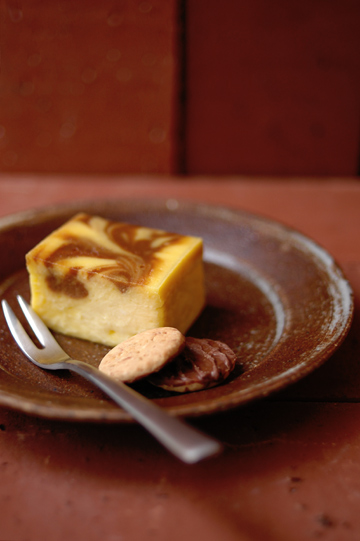
So I guess my first batch of caramelized white chocolate served good uses, other than going straight to my mouth in spoonfuls.
And yet, I wasn't completely happy with the results, nevertheless. Or more precisely, not with the excessively long cooking time it took for me to make it, that was. Even though I liked my caramelized white chocolate - or maybe because of it -, if I wanted to make it again (which I was sure I would, sooner rather than later) the thought of cooking it for more than 20 hours with stirring every 20-30 minutes was daunting. And I was sure it shouldn't be that way, even with my less-than-optimal oven.
So after I treated myself to those few sweet things with the milky caramel, I decided to give white chocolate - or maybe the oven, and/or myself - another shot. I picked up two 5-oz (150-g) bags of Valrhona Ivoire at my local baking supplies store, just like I had done for my first time around. Only this time I started straight off with the oven temperature set at 160C/325F, with 20- and then 30-minute intervals.
Things were definitely looking better this time. It still took about an hour or two before the chocolate started browning, but at Hour 4 or so, my chocolate looked nicely golden - almost. So I thought I'd give them the last 30-minute round.
Then I made a fatal mistake of leaving the oven unattended; in fact, I went out for a quick shopping and came back in half an hour. Stupid, I know. Coming home, first I noticed some burnt odor, and the next thing I saw was a sheet of what used to be white chocolate, burnt to death in the middle. It was shattered. So did I feel.
It was too burnt to do anything with it, it seemed, but I still tried a spoonful out of a part that was less burnt. It tasted fine, actually, but the chocolate was somewhat separated into hard, caramelized bits and oily liquid. Still, I recovered the less-burnt portion and collected it in a small jar.
Later when re-heated, it never made it back to a smooth paste, but it was a bit like praline sauce with a thin caramel and crunchy, nut-like bits. I realize I'm making it sound like something nice, some sort of a-new-classic-dessert-was-accidentally-born-out-of-a-mistake story, but it wasn't. At the end of the day, I ruined a good half of the batch after a 4-hour cooking, if not 24.
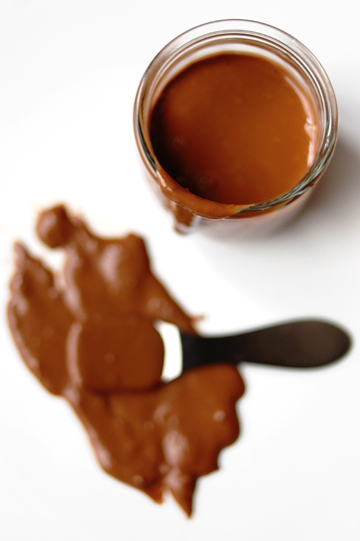
But one thing became clear at least: it doesn't take 20+ hours to make caramelized white chocolate, even in my stupid oven - as long as I'm not being stupid enough to take my eyes off from it at the last minute.
As for myself, now that I blew a total of 30 bucks on white chocolate for these two batches (one of which was a complete disaster), I'm in no hurry to give it a third try anytime soon (unless I get a sponsor!). But I have been thrilled to discover a whole new element of white chocolate, and I completely fell for it. Come autumn when the air is crisp and I 'm in the mood for slow cooking again, I can see myself stoking up on white chocolate and turn up the oven (not too high, though) to revisit this unusual delight. Who knows if my oven may still be the same helpless one, but I should then be smart enough not to repeat the same mistake - unless I'm trying to re-create a faux nut-free praline.
And by all this I hope I haven't given you the wrong impression that it inevitably demands unreasonably long hours of cooking and extra trouble to make your own caramelized white chocolate, because it shouldn't. With a proper, decent oven and an hour or so of your good attention as well as good-quality white chocolate, you won't be too far from a luscious batch of caramel goodie. If you love white chocolate and caramel like me, you'll love it. If you are normally dubious about white chocolate, you might still want to give it a shot and chances are you're utterly impressed with what you'll have. Failing that, just remember that I can always take care of it. Just don't send me a burnt batch, though.

5 comments:
this is a most luscious post! nothing beats chocolate!
i do enjoy chocolate from time to time, but i admit to being one of those strange people who will reach for a fruit tart before a chocolate dessert every time.
that said, this had me totally captivated. i'm impressed by all of the ways you've put the caramelized white chocolate to use... i fear i would have eaten it all with a spoon, or worse yet, my finger. bravo!
Yum Yum Yum!! These cuisine wonders are just lovely! Beautiful blog! :) please drop by mine too! :)
this sounds so good chika!
and i'm so tempted to make my own now. =D
I loved the post, great experience to share. I love white chocolate and it felt like you were talking to me....
Cheers,
C.
Post a Comment